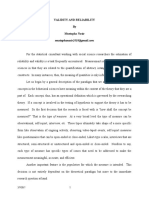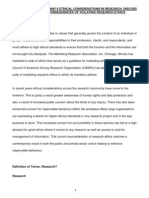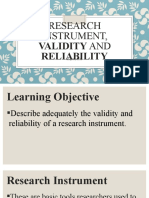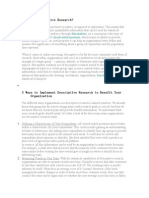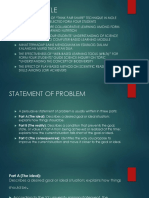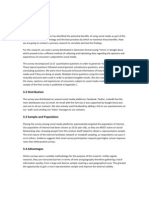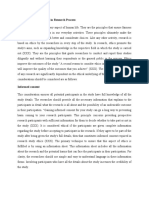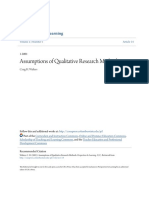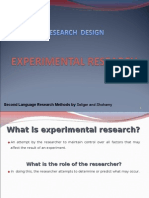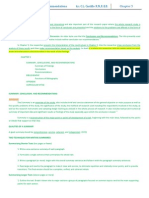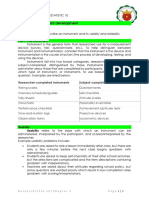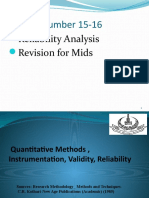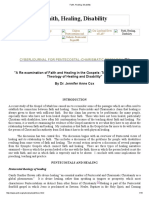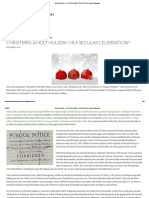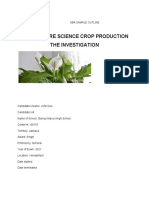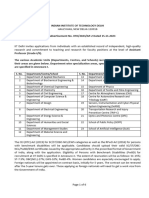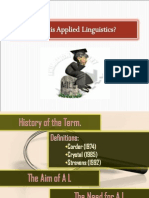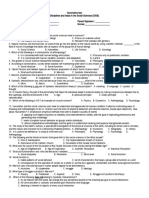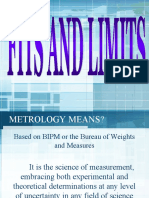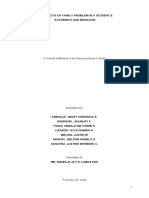Instrument Validity and Reliability in Research
Instrument Validity and Reliability in Research
Uploaded by
Precious UdoadaCopyright:
Available Formats
Instrument Validity and Reliability in Research
Instrument Validity and Reliability in Research
Uploaded by
Precious UdoadaOriginal Description:
Copyright
Available Formats
Share this document
Did you find this document useful?
Is this content inappropriate?
Copyright:
Available Formats
Instrument Validity and Reliability in Research
Instrument Validity and Reliability in Research
Uploaded by
Precious UdoadaCopyright:
Available Formats
Research Rundowns >Quantitative Methods > Instrumentation, Validity, Reliability Part I: The Instrument Instrument is the generic term
that researchers use for a measurement device (survey, test, questionnaire, etc.). To help distinguish between instrument and instrumentation, consider that the instrument is the device and instrumentation is the course of action (the process of developing, testing, and using the device). Instruments fall into two broad categories, researcher-completed and subject-completed, distinguished by those instruments that researchers administer versus those that are completed by participants. Researchers chose which type of instrument, or instruments, to use based on the research question. Examples are listed below: Researcher-completed Instruments Rating scales Interview schedules/guides Tally sheets Flowcharts Performance checklists Time-and-motion logs Observation forms Subject-completed Instruments Questionnaires Self-checklists Attitude scales Personality inventories Achievement/aptitude tests Projective devices Sociometric devices
Usability Usability refers to the ease with which an instrument can be administered, interpreted by the participant, and scored/interpreted by the researcher. Example usability problems include: 1. Students are asked to rate a lesson immediately after class, but there are only a few minutes before the next class begins (problem with administration). 2. Students are asked to keep self-checklists of their after school activities, but the directions are complicated and the item descriptions confusing (problem with interpretation). 3. Teachers are asked about their attitudes regarding school policy, but some questions are worded poorly which results in low completion rates (problem with scoring/interpretation). Validity and reliability concerns (discussed below) will help alleviate usability issues. For now, we can identify five usability considerations: 1. How long will it take to administer? 2. Are the directions clear? 3. How easy is it to score? 4. Do equivalent forms exist? 5. Have any problems been reported by others who used it? It is best to use an existing instrument, one that has been developed and tested numerous times, such as can be found in the Mental Measurements Yearbook. We will turn to why next.
Part II: Validity Validity is the extent to which an instrument measures what it is supposed to measure and performs as it is designed to perform. It is rare, if nearly impossible, that an instrument be 100% valid, so validity is generally measured in degrees. As a process, validation involves collecting and analyzing data to assess the accuracy of an instrument. There are numerous statistical tests and measures to assess the validity of quantitative instruments, which generally involves pilot testing. The remainder of this discussion focuses on external validity and content validity. External validity is the extent to which the results of a study can be generalized from a sample to a population. Establishing eternal validity for an instrument, then, follows directly from sampling. Recall that a sample should be an accurate representation of a population, because the total population may not be available. An instrument that is externally valid helps obtain population generalizability, or the degree to which a sample represents the population. Content validity refers to the appropriateness of the content of an instrument. In other words, do the measures (questions, observation logs, etc.) accurately assess what you want to know? This is particularly important with achievement tests. Consider that a test developer wants to maximize the validity of a unit test for 7th grade mathematics. This would involve taking representative questions from each of the sections of the unit and evaluating them against the desired outcomes. Part III: Reliability Reliability can be thought of as consistency. Does the instrument consistently measure what it is intended to measure? It is not possible to calculate reliability; however, there are four general estimators that you may encounter in reading research: 1. Inter-Rater/Observer Reliability: The degree to which different raters/observers give consistent answers or estimates. 2. Test-Retest Reliability: The consistency of a measure evaluated over time. 3. Parallel-Forms Reliability: The reliability of two tests constructed the same way, from the same content. 4. Internal Consistency Reliability: The consistency of results across items, often measured with Cronbach's Alpha. Relating Reliability and Validity Reliability is directly related to the validity of the measure. There are several important principles. First, a test can be considered reliable, but not valid. Consider the SAT, used as a predictor of success in college. It is a reliable test (high scores relate to high GPA), though only a moderately valid indicator of success (due to the lack of structured environment class attendance, parent-regulated study, and sleeping habits each holistically related to success). Second, validity is more important than reliability. Using the above example, college admissions may consider the SAT a reliable test, but not necessarily a valid measure of other quantities colleges seek, such as leadership capability, altruism, and civic involvement. The combination of these aspects, alongside the SAT, is a more valid measure of the applicants potential for graduation, later social involvement, and generosity (alumni giving) toward the alma mater. Finally, the most useful instrument is both valid and reliable. Proponents of the SAT argue that it is both. It is a moderately reliable predictor of future success and a moderately valid measure of a students knowledge in Mathematics, Critical Reading, and Writing.
Part IV: Validity and Reliability in Qualitative Research Thus far, we have discussed Instrumentation as related to mostly quantitative measurement. Establishing validity and reliability in qualitative research can be less precise, though participant/member checks, peer evaluation (another researcher checks the researchers inferences based on the instrument (Denzin & Lincoln, 2005), and multiple methods (keyword: triangulation), are convincingly used. Some qualitative researchers reject the concept of validity due to the constructivist viewpoint that reality is unique to the individual, and cannot be generalized. These researchers argue for a different standard for judging research quality. For a more complete discussion of trustworthiness, see Lincoln and Gubas (1985) chapter.
You might also like
- Living-in-Christ - Billy Graham PDFDocument27 pagesLiving-in-Christ - Billy Graham PDFPrecious Udoada75% (8)
- Validity and Reliability of Research InstrumentDocument47 pagesValidity and Reliability of Research Instrumentjeffersonsubiate100% (4)
- Validity and ReliabilityDocument6 pagesValidity and ReliabilityAngelica QuiñonesNo ratings yet
- Validation Tool For Interview Guide QuestionsDocument2 pagesValidation Tool For Interview Guide QuestionsPeperoniiNo ratings yet
- The Twentieth-Century Pentecostal - Charismatic Renewal in The Holy Spirit by David BarrettDocument11 pagesThe Twentieth-Century Pentecostal - Charismatic Renewal in The Holy Spirit by David BarrettPrecious UdoadaNo ratings yet
- Theory of Capitalism in German Economic Tradition PDFDocument576 pagesTheory of Capitalism in German Economic Tradition PDFStraza100% (1)
- Accreditation Guide To IchemeDocument62 pagesAccreditation Guide To Ichemejimbob8888No ratings yet
- Flinn Safety FormDocument1 pageFlinn Safety Formapi-295147740No ratings yet
- Reliability and ValidityDocument6 pagesReliability and Validityhafnialfu100% (1)
- Validity and ReliabilityDocument6 pagesValidity and ReliabilityMustapha Nasir MalumfashiNo ratings yet
- A Correlational Study Between Facebook Intensity Usage and Social Anxiety of Senior High School Students in FEBNHS-1 PDFDocument64 pagesA Correlational Study Between Facebook Intensity Usage and Social Anxiety of Senior High School Students in FEBNHS-1 PDFRobin SalivaNo ratings yet
- Research Methodology Ethical Issues in Research - An AssignmentDocument11 pagesResearch Methodology Ethical Issues in Research - An AssignmentSylvia MabodoNo ratings yet
- Research Instrument Validity and ReliabilityDocument16 pagesResearch Instrument Validity and ReliabilityRENIER ACE ABORDO100% (1)
- Validity, Reliability, Data Collection, Data AnalysisDocument81 pagesValidity, Reliability, Data Collection, Data AnalysisAina Francheska E. HernandezNo ratings yet
- Review of Related Literature in Academic Adjustment of First YearDocument3 pagesReview of Related Literature in Academic Adjustment of First YearChanz Caballero Pagayon80% (5)
- Descriptive Survey Research WRDocument10 pagesDescriptive Survey Research WRJessa Mae ClamorNo ratings yet
- Reliability and Validity of Qualitative and Operational Research ParadigmDocument11 pagesReliability and Validity of Qualitative and Operational Research ParadigmMadiha Khan100% (2)
- Questionnaire Reliability and ValidityDocument3 pagesQuestionnaire Reliability and ValidityDrAnkit K S PatelNo ratings yet
- What Is TrustworthinessDocument12 pagesWhat Is Trustworthinesswwccff100% (1)
- Theoretical and Conceptual FrameworkDocument9 pagesTheoretical and Conceptual FrameworkJavea Villagracia100% (2)
- Medicinal Mushroom Science Current, Advances Evidences and ChallengesDocument12 pagesMedicinal Mushroom Science Current, Advances Evidences and ChallengeskierkegardNo ratings yet
- Thesis Methodology (Student Activism)Document4 pagesThesis Methodology (Student Activism)PJ Polanco ValenciaNo ratings yet
- What Is Descriptive ResearchDocument7 pagesWhat Is Descriptive ResearchEden EscaloNo ratings yet
- Types of ValidityDocument4 pagesTypes of Validitydanieljohnarboleda100% (1)
- Research TitleDocument6 pagesResearch TitlenorizanNo ratings yet
- Quasi Experimental DesignDocument4 pagesQuasi Experimental DesignPatriciaIvanaAbiog100% (1)
- Reliability & ValidityDocument33 pagesReliability & ValidityKhalilahanum Zainal Abidin100% (1)
- The Scope and Limitations of The StudyDocument9 pagesThe Scope and Limitations of The StudyKim Joaquin100% (1)
- MethodologyDocument2 pagesMethodologyakanksha_cNo ratings yet
- Concept of Reliability and ValidityDocument6 pagesConcept of Reliability and ValidityAnjaliNo ratings yet
- Theoritical FrameworkDocument4 pagesTheoritical FrameworkBryan Clareza0% (1)
- Validity and ReliabilityDocument22 pagesValidity and ReliabilityPavi Arul100% (1)
- Research MethodologyDocument1 pageResearch MethodologyDerek SardoncilloNo ratings yet
- What Is Quantitative ResearchDocument3 pagesWhat Is Quantitative Researchcatharina100% (2)
- Ethical ConsiderationsDocument3 pagesEthical ConsiderationsJen NishNo ratings yet
- Assumptions of Qualitative Research MethodsDocument4 pagesAssumptions of Qualitative Research MethodsArris Gian GaweNo ratings yet
- Quantitative Research DesignDocument26 pagesQuantitative Research DesignJazyrin M. Pullan100% (1)
- The Research InstrumentsDocument35 pagesThe Research InstrumentsYolanda Teves Sobrepena100% (1)
- Ethical Consideration in ResearchDocument10 pagesEthical Consideration in ResearchSalvador Dagoon JrNo ratings yet
- Populations and SamplingDocument21 pagesPopulations and SamplingDavisson M. Francisco50% (2)
- Research GapDocument1 pageResearch GapJohn Patrick MolinaNo ratings yet
- Experimental ResearchDocument50 pagesExperimental Researchliz8585100% (5)
- Pretest Posttest DesignDocument7 pagesPretest Posttest DesignrzesquieresNo ratings yet
- The 4 Types of Validity - Explained With Easy ExamplesDocument10 pagesThe 4 Types of Validity - Explained With Easy ExamplesAhmad MakhloufNo ratings yet
- Chapter 5Document11 pagesChapter 5Carmina CastilloNo ratings yet
- Properties of Assessment Method: ValidityDocument30 pagesProperties of Assessment Method: ValidityDANIEL LANCE RESPONTE NEVADONo ratings yet
- Chapter 3Document9 pagesChapter 3RocheeBalaneNo ratings yet
- Quantitative Research DesignDocument8 pagesQuantitative Research DesignAufa liaNo ratings yet
- Students Satisfaction Level Towards Enrollment System Services Provided1Document13 pagesStudents Satisfaction Level Towards Enrollment System Services Provided1DaveHenryFernandez100% (2)
- Chapter Three Research Methodology 3.0. Introduction: March 2020Document6 pagesChapter Three Research Methodology 3.0. Introduction: March 2020Danica SoriaNo ratings yet
- Chapter 3Document14 pagesChapter 3Jericho EscanoNo ratings yet
- Chapter 3 ResearchDocument5 pagesChapter 3 ResearchLea Mae Bautisat50% (2)
- Multi Method ResearchDocument15 pagesMulti Method Researchahmeddawod100% (3)
- Kinds of Quantitative Research DesignsDocument11 pagesKinds of Quantitative Research DesignsmicahdiannedizonNo ratings yet
- Convenience Sampling DefinitionDocument3 pagesConvenience Sampling DefinitionJem BicolNo ratings yet
- Objective of The StudyDocument4 pagesObjective of The StudyeshuNo ratings yet
- Research: Its Nature, Types and Role in DevelopmentDocument7 pagesResearch: Its Nature, Types and Role in Developmentsagami.g92% (24)
- Establishing-Trustworthiness-of-Data 2Document2 pagesEstablishing-Trustworthiness-of-Data 2Adine Jeminah LimonNo ratings yet
- Research MethodologyDocument4 pagesResearch MethodologyEdeth SubongNo ratings yet
- Chapter 4 Depression and AnxietyDocument3 pagesChapter 4 Depression and AnxietyChristian VillaNo ratings yet
- InstrumentDocument4 pagesInstrumenthashamraza74No ratings yet
- Part I: The Instrument: Researcher-Completed Instruments Subject-Completed InstrumentsDocument2 pagesPart I: The Instrument: Researcher-Completed Instruments Subject-Completed InstrumentsMohamedNo ratings yet
- CHAPTER-5 Research PDFDocument3 pagesCHAPTER-5 Research PDFhiroe sagaraNo ratings yet
- Hand-Out About Instrumentation and Statistical TreatmentDocument3 pagesHand-Out About Instrumentation and Statistical TreatmentBlack PrankNo ratings yet
- L 15-16, Reliability AnalysisDocument17 pagesL 15-16, Reliability AnalysisShan AliNo ratings yet
- Keswick Theology: A Survey and Analysis of The Doctrine of Sanctification in The Early Keswick MovementDocument51 pagesKeswick Theology: A Survey and Analysis of The Doctrine of Sanctification in The Early Keswick MovementPrecious Udoada100% (1)
- Good - Quotes - T. L. OsbornDocument3 pagesGood - Quotes - T. L. OsbornPrecious Udoada100% (3)
- The Miracle of SalvationDocument6 pagesThe Miracle of SalvationPrecious UdoadaNo ratings yet
- Five Critical Disciplemaking Questions - EFCA PDFDocument3 pagesFive Critical Disciplemaking Questions - EFCA PDFPrecious Udoada100% (1)
- EnduedDocument3 pagesEnduedPrecious UdoadaNo ratings yet
- A Re-Examination of Faith and Healing in The Gospels: Toward A Pentecostal Theology of Healing and DisabilityDocument15 pagesA Re-Examination of Faith and Healing in The Gospels: Toward A Pentecostal Theology of Healing and DisabilityPrecious UdoadaNo ratings yet
- Language and The Early Manuscripts by Ken BarkerDocument3 pagesLanguage and The Early Manuscripts by Ken BarkerPrecious UdoadaNo ratings yet
- Abigail A Woman of Strength and Wisdom Encounter - Online JournalDocument3 pagesAbigail A Woman of Strength and Wisdom Encounter - Online JournalPrecious UdoadaNo ratings yet
- Christmas - A Holy Holiday or A Secular Celebration by Kevin PendergrassDocument38 pagesChristmas - A Holy Holiday or A Secular Celebration by Kevin PendergrassPrecious UdoadaNo ratings yet
- Tithe and Offering Scriptures BibliographyDocument5 pagesTithe and Offering Scriptures BibliographyPrecious UdoadaNo ratings yet
- Simon Sinek - How Great Leaders Inspire Action - TED Talk Subtitles and Transcript - TEDDocument7 pagesSimon Sinek - How Great Leaders Inspire Action - TED Talk Subtitles and Transcript - TEDPrecious UdoadaNo ratings yet
- How Great Thou Art LyricsDocument1 pageHow Great Thou Art LyricsPrecious UdoadaNo ratings yet
- John Wooden - The Difference Between Winning and Succeeding - TED TalkDocument10 pagesJohn Wooden - The Difference Between Winning and Succeeding - TED TalkPrecious UdoadaNo ratings yet
- The Gospel According To John 3:16Document5 pagesThe Gospel According To John 3:16Precious UdoadaNo ratings yet
- Is It A Sin For A Christian To Drink Alcohol - WineDocument2 pagesIs It A Sin For A Christian To Drink Alcohol - WinePrecious UdoadaNo ratings yet
- What Is A Plant?Document35 pagesWhat Is A Plant?Precious UdoadaNo ratings yet
- Holy Ghost Revival Lyrics by Joel HemphilDocument1 pageHoly Ghost Revival Lyrics by Joel HemphilPrecious UdoadaNo ratings yet
- NT Students Manual MormonsDocument601 pagesNT Students Manual MormonsPrecious UdoadaNo ratings yet
- Spiritual Prowess NoteDocument2 pagesSpiritual Prowess NotePrecious Udoada100% (1)
- 1945 Labour Party Election ManifestoDocument10 pages1945 Labour Party Election ManifestoPrecious UdoadaNo ratings yet
- Sba Sample OutlineDocument52 pagesSba Sample OutlineGarwayne McKenzieNo ratings yet
- Remote Sensing: 2 Semester Academic Year 2015-2016Document20 pagesRemote Sensing: 2 Semester Academic Year 2015-2016Rhea CelzoNo ratings yet
- GeSocSci 6 Mod 2 SummaryDocument3 pagesGeSocSci 6 Mod 2 SummaryLeo Junz A. FABILA IIINo ratings yet
- Dept Day Talk Butterfly TalkDocument2 pagesDept Day Talk Butterfly TalkJYOTIPRASAD DEKANo ratings yet
- Prospectus 2019-2020 PDFDocument25 pagesProspectus 2019-2020 PDFGargi UpadhyayaNo ratings yet
- (Paul Hawken, Amory Lovins, L. Hunter Lovins) Natu (B-Ok - Xyz) Part6Document1 page(Paul Hawken, Amory Lovins, L. Hunter Lovins) Natu (B-Ok - Xyz) Part6asmuviqNo ratings yet
- POLS-8500-syllabus-text As Data UGADocument4 pagesPOLS-8500-syllabus-text As Data UGADavid WalkerNo ratings yet
- AR 2250 Accreditation Requirements - ISO - IEC 17025 Testing Laboratories-8160-6Document9 pagesAR 2250 Accreditation Requirements - ISO - IEC 17025 Testing Laboratories-8160-6Sreenath KooliyattuNo ratings yet
- Maken Sense - HinshelwoodDocument13 pagesMaken Sense - HinshelwoodEver KarNo ratings yet
- A Study On Satisfaction of Employees On Recruitment Process at Snap It StudioDocument14 pagesA Study On Satisfaction of Employees On Recruitment Process at Snap It Studioanisamanta02No ratings yet
- Pressure Measurement Part 1 of 3 PDFDocument13 pagesPressure Measurement Part 1 of 3 PDFSimanjuntak JulpianNo ratings yet
- Complexity in Engineering Design and ManufacturingDocument22 pagesComplexity in Engineering Design and ManufacturingMariaAngelicaNo ratings yet
- SSC1 Lesson 4Document12 pagesSSC1 Lesson 4Ken OlarteNo ratings yet
- Outline of Literature Review PaperDocument4 pagesOutline of Literature Review Paperafmztopfhgveie100% (1)
- James Ladyman - Understanding Philosophy of Science-Routledge (2002) (Dragged)Document13 pagesJames Ladyman - Understanding Philosophy of Science-Routledge (2002) (Dragged)lalit saraswat100% (3)
- Rollling Adv - IITD 2023 AP-2-minDocument19 pagesRollling Adv - IITD 2023 AP-2-mintltnmbspgxnwclsnpzNo ratings yet
- Definition of Applied LinguisticsDocument20 pagesDefinition of Applied LinguisticsJayan NairNo ratings yet
- Literature Review Consolidated-1Document31 pagesLiterature Review Consolidated-1Khalid Noor MohammedNo ratings yet
- How To Start An Informative Research PaperDocument4 pagesHow To Start An Informative Research Paperefdkhd4eNo ratings yet
- 3rd-Quarter-Exam-DISS 2021Document4 pages3rd-Quarter-Exam-DISS 2021MlynNo ratings yet
- Chapter Three Philo of Scie Lecture NoteDocument18 pagesChapter Three Philo of Scie Lecture Notemekinjemal999No ratings yet
- Lecture OnlineDocument41 pagesLecture OnlineDhayane RedoquerioNo ratings yet
- In Partial Fulfillment of The Requirements in MathDocument4 pagesIn Partial Fulfillment of The Requirements in MathDixie NormousNo ratings yet
- Obe Bcomm - HRMDocument11 pagesObe Bcomm - HRMpearlybethogayonNo ratings yet
- Cambridge Companion To Philosophical MethodologyDocument9 pagesCambridge Companion To Philosophical MethodologyRob ThuhuNo ratings yet
- Topic 1 Teacher and Mathematics EducationDocument21 pagesTopic 1 Teacher and Mathematics EducationDerrick Yong Thien Foh0% (1)
- Society and Culture With Family Planning PDFDocument7 pagesSociety and Culture With Family Planning PDFmelchieNo ratings yet









